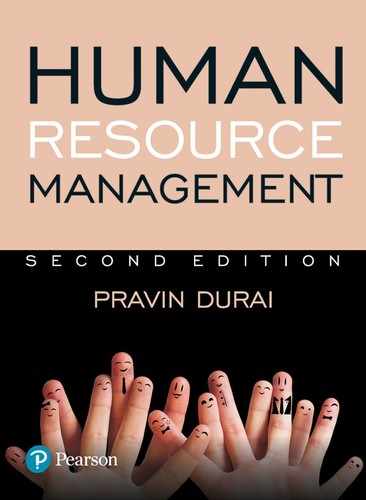APPENDIX E
Employee Life Cycle Management
The employee life cycle is of late emerging as an important concept in human resources management. In today’s marketplace, it is imperative that employers properly understand and manage the employee life cycle. The employee life cycle refers to the various stages of employment process. The primary goal of any employee life cycle management is to implement processes aimed at improving the quality, productivity, and job retention of employees. This life cycle actually describes the stages of an employee’s time with a particular company and the role to be performed by human resource (HR) department at each stage. Employee’s life cycle in an organization begins with recruitment and ends with termination, which also includes several stages in between including career development. In simple terms, employee life cycle involves hiring of employees, then managing them on a day-to-day basis, and finally preparing them to exit from organization. Employee life cycle management involves identification of the stages in employees’ career and to help guide their career management in a mutually beneficial manner.
The employee life cycle in a particular organization can last for decades, years, or even days. The various stages of the employee life cycle decide the HR techniques for each individual employee. Each employee is usually at a different place at a different time in this cycle. This Employee life cycle involves the execution of specific HR activities such as recruitment planning and selection, induction preparation, performance management, motivating, engaging and developing employees, managing discipline and grievance, succession planning, and managing the transition. Surely, an organization’s life cycle effectiveness can be enhanced when it facilitates employee life cycles. For instance, employees’ performance can be enhanced by understanding where employees stand within the employee life cycle. The effectiveness of succession planning can also be enhanced when managers are aware of where employees are in their career life cycle. Many managers believe that effective employee life cycle management can help them in reducing the organization’s cost per employee. As a result, managers are developing strategies for each stage of employee life cycle. We shall now see the common stages in employee life cycle (Figure E.1) and the HR intervention required.
The following are the stages of employee life cycle management:
- Acquire: The first and most important stage in employee life cycle is acquiring or hiring suitable people for the jobs. This stage requires careful analysis of the job and its function. Besides, organizations should use appropriate selection techniques for choosing the right persons. When a wrong person is hired, then the life cycle will be short. Moreover, the cost of replacing a wrong hire usually exceeds the cost of hiring the best person in the first attempt.1 According to a report, the cost of a bad hire to an organization is five times the bad hire’s annual salary.2 Organizational culture, attractive remuneration packages, equal employment opportunities, effective advertising, in-depth interviews, and professional communication play an important role in bringing right people to the organization. Proper screening of applications by organizations is a crucial aspect of the overall hiring process for selecting right candidates.3
- Inspire: After hiring, the next stage in employee life cycle is inspiring the employees to perform better in their job. In this regard, organizations normally conduct various training and orientation programmes to make sure that the employees are aware of their responsibilities and comfortable in the new role. Through training, employees get a feel of the organization which in turn helps them shape their attitude towards the job and the organizational members. This stage also involves challenging and motivating employees to give their best efforts for their personal as well as organizational growth.
- Admire: After inspiring the employees to work willingly and effectively towards goal accomplishment, the next stage in employee life cycle is admiring the employees for the good work done. When employees are not recognized in a just and timely manner, their motivation and satisfaction is bound to decline. When the employees perceive their job, superiors, or organization negatively, they are more likely to leave the organization early. Efficient performance evaluation, fair and timely promotional opportunities, and effective monetary incentive are useful HR techniques for recognizing and admiring the good work of employees.
- Retire: At this stage, the employees’ relationship with the organization comes to an end. It may happen through retirement, resignation, or termination of employees. When an employee completes full or long tenure with the organization before leaving, it indicates the success of HR practices adopted at various stages of employee life cycle. When the organization succeeds in hiring, inspiring, and admiring the right talents, it can enhance both the employee life cycle and organizational life cycle substantially. When employees stay longer, it encourages other potential employees to join the organization. It also creates goodwill for the organization in the labour market.
Generally, the employee life cycle approach to people management calls for a unique set of HR initiatives and processes. This is because the employee life cycle generally differs from one organization to another depending on the size and nature of operations. However, a well-planned and flexible employee life cycle approach to HR management can add great value to any organizations.
Notes
- Ramesh Gulati, Ricky Smith, Maintenance and Reliability Best Practices, (NY: Induxtrial Press Inc, 2009), p. 277.
- Report of society for human resource management referred in the article entitled ‘A Bad Hire Costs His Firm 5 Times His Annual Salary’ published in The Hindu, 27th May 2015, p. 16.
- Report of society for human resource management referred in the article entitled ‘A Bad Hire Costs His Firm 5 Times His Annual Salary’ published in The Hindu, 27th May 2015, p. 16.

